Iguana
 From Nwe
From Nwe | Iguana | ||||||||||||||
|---|---|---|---|---|---|---|---|---|---|---|---|---|---|---|
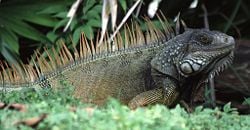
A green iguana (Iguana iguana)
|
||||||||||||||
| Scientific classification | ||||||||||||||
|
||||||||||||||
|
|
||||||||||||||
|
Iguana is both the common name for several of the larger members of tropical lizards in the family Iguanidae, and the scientific name of the genus within Iguanidae comprised of two extant members, the green iguana (I. iguana) and the lesser Antillean iguana (I. delicatissima). In the broader sense, iguanas are scattered over several genera and include the desert iguana (Dipsosaurus dorsalis), the marine iguana (Amblyrhynchus cristatus), Galápagos land iguanas (genus Conolophus), and spiny-tailed iguanas (genus Ctenosaura). The iguana family, Iguanidae, also includes smaller species whose members are not called iguanas.
Iguanas provide values for the ecosystem and for humans. Ecologically, they are important to food chains, consuming largely plant matter and being eaten by various predators. For humans, they add to the wonder of nature and the green iguana has been a popular food source in Central and South America for the past 7000 years, as well as a popular pet.
The word "Iguana" is derived from a Spanish form of the original Taino name for the species, "Iwana" (Coles 2002).
Iguanidae
Iguanidae is a family of lizards composed of iguanas and related species, including the green iguana commonly kept as a pet. The term "lizard" refers to any of the numerous reptiles of the suborder Sauria (or Lacertilia) of the order Squamata. As lizards, iguanas are characterized by having less flexible jaws than snakes, movable eyelids, external ear openings, and have four-well developed limbs, as well as an integumentary system comprised of scales, with a skull composed of quadrate bones.

In addition to iguanas, which in a general sense refer to the larger members of Iguanidae, the family includes the chuckwalla (Sauromalus obesus), the side-blotched lizards (genus Uta), and the anole (subfamily Polychrotinae, although sometimes placed in its own family Plychrotidae), among others.
Two different classification schemes have been used to define the structure of this family. These are the "traditional" classifications and the classifications presented by Frost et al. (1989).
The traditional classification is as follows:
Family Iguanidae
- Subfamily Corytophaninae: Casquehead lizards
- Subfamily Crotaphytinae: Collared and leopard lizards
- Subfamily Hoplocercinae: Wood lizards, clubtails
- Subfamily Iguaninae: Green iguanas and spinytail iguanas
- Subfamily Leiocephalinae
- Subfamily Leiosaurinae
- Subfamily Liolaeminae
- Subfamily Oplurinae: Madagascar iguanids
- Subfamily Phrynosomatinae: Ear-less, spiny, tree, side-blotched and horned lizards
- Subfamily Polychrotinae: Anoles
- Subfamily Tropidurinae: Neotropical ground lizards
.
Frost et al. (1989) redefined this family. The genera belonging to the various subfamilies were assigned to separate families. This view is not generally accepted and the "traditional" classification is still widely used. The Frost et al. (1989) system is as follows:
Family Iguanidae
- Genus Amblyrhynchus
- Genus Brachylophus
- Genus Conolophus
- Genus Ctenosaura
- Genus Cyclura
- Genus Dipsosaurus
- Genus Iguana
- Genus Sauromalus
- Genus Armandisaurus (extinct)
- Genus Lapitiguana (extinct)
- Genus Pumila (extinct)
The Iguana genus includes lizards native to tropical areas of Central and South America and the Caribbean, first described by Austrian naturalist Josephus Nicolaus Laurenti in his book, Specimen Medicum, Exhibens Synopsin Reptilium Emendatam cum Experimentis circa Venena, in 1768. The genus Iguana includes two species: The green iguana and the Lesser Antillean iguana.
Green iguana
The green iguana (Iguana iguana) is a large, arboreal herbivorous species of lizard of the genus iguana, native to Central and South America. The green iguana ranges over a large geographic area, from southern Brazil and Paraguay to as far north as Mexico and the Caribbean Islands. In the United States, it exists as feral populations in Florida, Hawaii and the Rio Grande Valley of Texas. The green iguana is commonly found in captivity.
The green iguana grows to 1.5 meters in length from head to tail, although a few specimens have grown more than 2 meters (6 feet) and can weigh upwards of 20 pounds (10 kg). In southern countries of their range, such as Peru, green iguanas appear bluish in color with bold black markings (Samuelson 1995). On islands such as Bonaire, Curacao, Aruba, and Grenada, a green iguana's color may range from green to lavender, black, and even pink (de Vosjoli and Blair 1992; Samuelson 1995). Green iguanas from the western region of Costa Rica are red and animals of the northern ranges, such as Mexico, appear orange (de Vosjoli and Blair 1992; Samuelson 1995). Juvenile green iguanas from El Salvador are often bright blue as babies; however they lose this color as they get older (De Vosjoli and Blair 1992).
Green iguanas possess a row of spines along their backs and along their tails that helps to protect them from predators (Samuelson 1995). Their whip-like tails can be used to deliver painful strikes and, like many other lizards, the tail can break off when grabbed, allowing the iguana to escape. In addition, iguanas have well developed dewlaps, which help regulate their body temperature (Bebler and King 1979). It is also used in courtships and displays (de Vosjoli and Blair 1992; Samuelson 1995; Conant and Collins 1991).
Green iguanas are diurnal and arboreal and often found near water (Cogger and Zweifel 1992; Samuelson 1995). During cold, wet weather, green iguanas prefer to stay on the ground for greater warmth (Swanson 1950). They can also swim. When swimming, an iguana remains submerged and lets its four legs hang limply against its side and propels itself through the water with powerful tail strokes (Swanson 1950).
Because of the green iguana's popularity in the pet trade and as a food source in Latin America, they are listed on the CITES Appendix II, which means that while they are not an endangered species, "their trade must be controlled so as to not harm the species in the future" (CITES 2007).
Green iguanas have evolved a white photosensory organ on the top of their heads called the parietal eye, which are also called a third eye, pineal eye, or pineal gland (Brames 2007). This “eye” does not work the same way as a normal eye does, as it has only a rudimentary retina and lens and thus cannot form images (Brames 2007). It is, however, sensitive to changes in light and dark and can detect movement, helping the iguana when being stalked by predators from above (Brames 2007).
Green iguanas from Guatemala and southern Mexico have small horns on their snouts between their eyes and their nostrils, whereas others do not (Samuelson 1995). Naturalists once classified these iguanas as belonging to different subspecies (Iguana iguana rhinolopha); however, this classification has been found to be invalid as iguanas with similar nose projections appear randomly in other populations and interbreed freely with those that do not share this trait (Samuelson 1995). The Moche people of ancient Peru worshiped animals and often depicted Green iguanas in their art (Berrin and Larco Museum 1997). The iguana has also been used as a food source in Central and South America for the past 7000 years. In Central and South America, green iguanas are used as a source of meat and are often referred to as gallina de palo, "bamboo chicken" or "chicken of the tree" (Swanson 1950).
Lesser Antillian iguana
The Lesser Antillean iguana (Iguana delicatissima) is another of two species of lizard of the genus Iguana. Endemic to the Lesser Antilles, it is in severe decline due to habitat destruction, feral predators, hunting, and hybridization with its sister species, the green iguana. The Lesser Antillean iguana is found in scrub woodland, rainforest, and mangrove throughout the Lesser Antilles on Anguilla, St. Martin, St. Eustatius, Antigua, Guadeloupe, Dominica, and Martinique (van den Burg et al. 2018).
Though belonging to the same genus as the green iguana, the Lesser Antilles iguana has a more blocky, shortened face than the green iguana and lacks the distinctive stripe pattern present along the green iguana's tail. The feature that most easily distinguishes these two species is the large, round scale, which the green iguana has below each ear hole, but the Lesser Antillean iguana does not.
The Lesser Antillean iguana varies in color between different island populations, but the base color tends to be gray, with green splotching on the underside (Lazell 1973). They have large, pale, ivory colored scales on their heads. The jowls of males are pink and the scales around the eyes are blue (Lazell 1973). Males are larger than females and are 40 centimeters (16 inches) long, with an 80-centimeter (32-inch) tail when full-grown. Females are two-thirds this size.
Like the green iguana, Lesser Antillean iguanas are primarily herbivores.
The Lesser Antillean iguana is a vulnerable species and is found on the IUCN Red List (van den Burg et al. 2018). While it is legally protected from hunting throughout its range, enforcement of these regulations is extremely difficult and therefore limited. Other threats include habitat loss to agriculture and development and the introduction of feral predators such as dogs and cats.
The species' greatest threat is from its own genus . The green iguana has been introduced to the Lesser Antilles as an invasive species and directly competes with the Lesser Antillean iguana for food and resources. In addition, the green iguana has been interbreeding with the Lesser Antillean iguana and this hybridization has been the number one reason for decline on at least three of the islands: Les Iles des Saintes, Basse Terre (Guadeloupe) and St. Barthélemy.
References
ISBN links support NWE through referral fees
- Bebler, J. L., and F. W. King. 1979. The Audubon Society Field Guide to Reptiles and Amphibians of North America. New York: Alfred A. Knopf. ISBN 0394508246
- Berrin, K., and Larco Museum. 1997. The Spirit of Ancient Peru: Treasures from the Museo Arqueológico Rafael Larco Herrera. New York: Thames and Hudson. ISBN 0500018022
- Brames, H. 2007. Aspects of light and reptile immunity. Iguana: Conservation, Natural History, and Husbandry of Reptiles 14(1): 19-23.
- CITIES. 2007. Appendices I,II, and III. Convention on International Trade in Endangered Species of Wild Fauna and Flora. Retrieved May 28, 2021.
- Cogger, H., and R. Zweifel. 1992. Reptiles & Amphibians. Sydney, Australia: Weldon Owen. ISBN 0831727861
- Coles, W. 2002. Green iguana. U.S.V.I. Animal Fact Sheet #08, Department of Planning and Natural Resources, US Virgin Islands Division of Fish and Wildlife. Retrieved May 28, 2021.
- Conant, R., and J. Collins. 1991. A Field Guide to Reptiles and Amphibians Eastern/Central North America. Boston, MA: Houghton Mifflin Company. ISBN 0395583896
- De Vosjoli, P., and D. Blair. 1992. The Green Iguana Manual. Escondido, California: Advanced Vivarium Systems. ISBN 74886904040
- Frost, D. R., and R. E. Etheridge. 1989. A Phylogenetic Analysis and Taxonomy of Iguanian Lizards (Reptilia: Squamata). Lawrence, KS: University of Kansas, Museum of Natural History. ISBN 0893380334
- Frost, D. R., R. Etheridge, D. Janies, and T. A. Titus. 2001. Total evidence, sequence alignment, evolution of Polychrotid lizards, and a reclassification of the Iguania (Squamata: Iguania). American Museum Novitates. 3343: 38.
- Lazell, J. D. 1973. The lizard genus Iguana in the Lesser Antilles. Bulletin of the Museum of Comparative Zoology 145: 1-28.
- Samuelson, P. 1995. The lizard king. Reptiles Magazine 3(2): 64-84.
- Swanson, P. L. 1950. The Iguana: Iguana iguana iguana. Herpetolgica 6: 187-193.
- van den Burg, M.P., Breuil, M.. and Knapp, C. 2018. Iguana delicatissima. IUCN Red List of Threatened Species. Retrieved May 28, 2021.
Credits
New World Encyclopedia writers and editors rewrote and completed the Wikipedia article in accordance with New World Encyclopedia standards. This article abides by terms of the Creative Commons CC-by-sa 3.0 License (CC-by-sa), which may be used and disseminated with proper attribution. Credit is due under the terms of this license that can reference both the New World Encyclopedia contributors and the selfless volunteer contributors of the Wikimedia Foundation. To cite this article click here for a list of acceptable citing formats.The history of earlier contributions by wikipedians is accessible to researchers here:
The history of this article since it was imported to New World Encyclopedia:
Note: Some restrictions may apply to use of individual images which are separately licensed.
↧ Download as ZWI file | Last modified: 02/04/2023 00:43:31 | 2 views
☰ Source: https://www.newworldencyclopedia.org/entry/Iguana | License: CC BY-SA 3.0
 ZWI signed:
ZWI signed: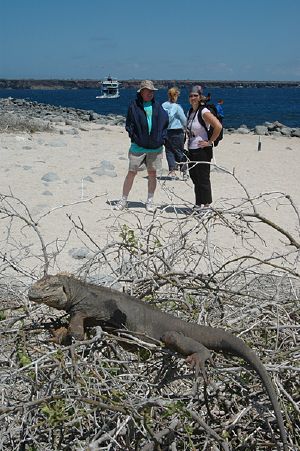
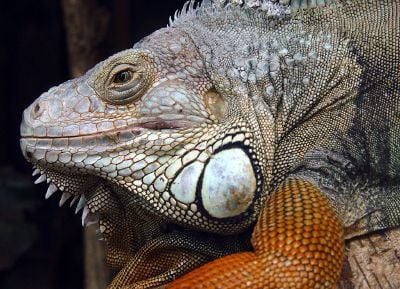
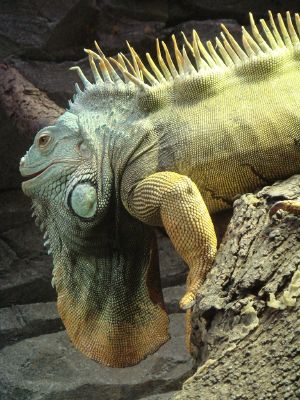
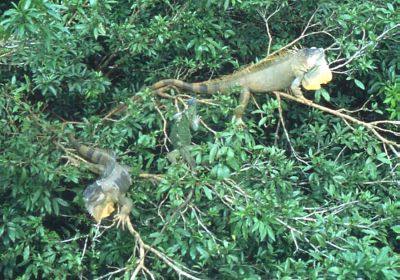
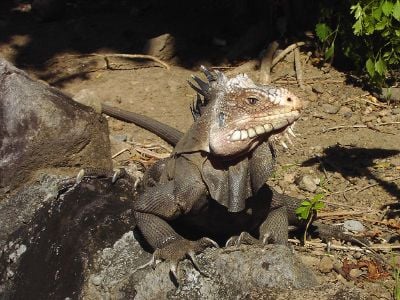
 KSF
KSF